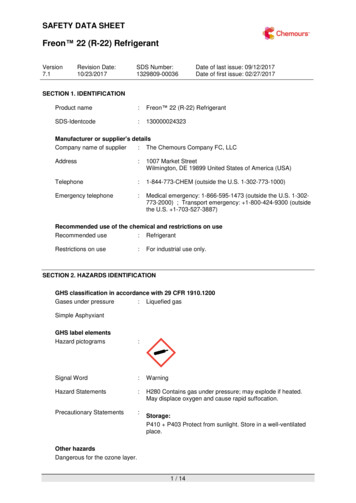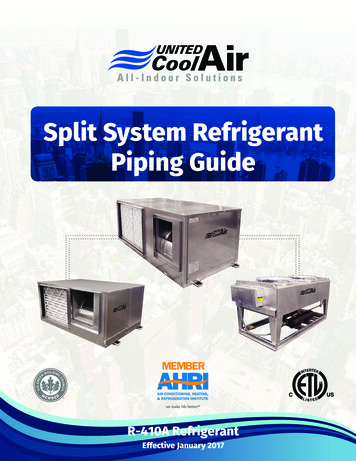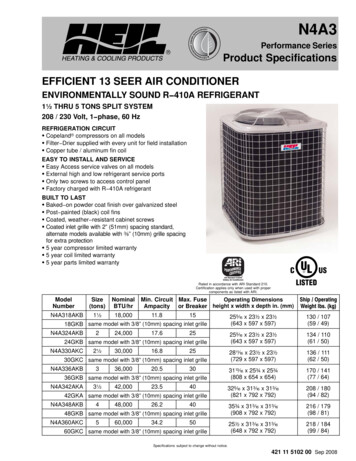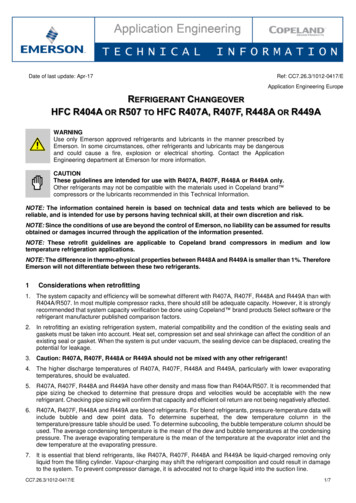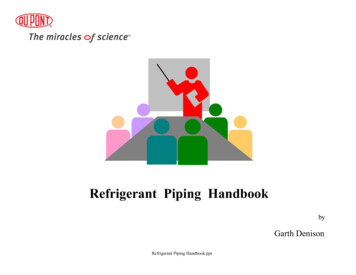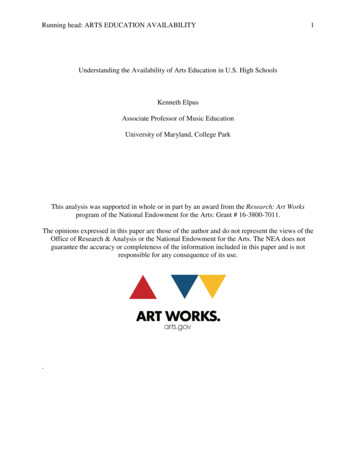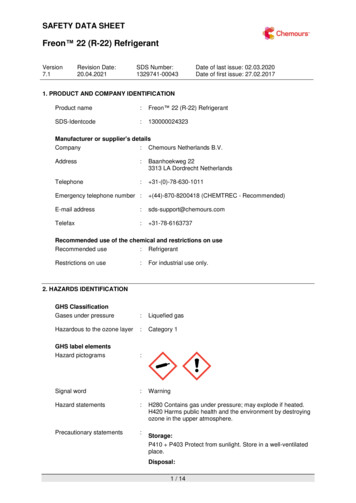
Transcription
SAFETY DATA SHEETFreon 22 (R-22) RefrigerantVersion7.1Revision Date:20.04.2021SDS Number:1329741-00043Date of last issue: 02.03.2020Date of first issue: 27.02.20171. PRODUCT AND COMPANY IDENTIFICATIONProduct name:Freon 22 (R-22) RefrigerantSDS-Identcode:130000024323Manufacturer or supplier's detailsCompany: Chemours Netherlands B.V.Address:Baanhoekweg 223313 LA Dordrecht NetherlandsTelephone: 31-(0)-78-630-1011Emergency telephone number : (44)-870-8200418 (CHEMTREC - Recommended)E-mail address:sds-support@chemours.comTelefax: 31-78-6163737Recommended use of the chemical and restrictions on useRecommended use: RefrigerantRestrictions on use:For industrial use only.GHS ClassificationGases under pressure:Liquefied gasHazardous to the ozone layer:Category 1GHS label elementsHazard pictograms:Signal word:WarningHazard statements:H280 Contains gas under pressure; may explode if heated.H420 Harms public health and the environment by destroyingozone in the upper atmosphere.Precautionary statements:2. HAZARDS IDENTIFICATIONStorage:P410 P403 Protect from sunlight. Store in a well-ventilatedplace.Disposal:1 / 14
SAFETY DATA SHEETFreon 22 (R-22) RefrigerantVersion7.1Revision Date:20.04.2021SDS Number:1329741-00043Date of last issue: 02.03.2020Date of first issue: 27.02.2017P502 Refer to manufacturer or supplier for information on recovery or recycling.Other hazards which do not result in classificationVapours are heavier than air and can cause suffocation by reducing oxygen available for breathing.Misuse or intentional inhalation abuse may cause death without warning symptoms, due to cardiac effects.Rapid evaporation of the product may cause frostbite.May displace oxygen and cause rapid suffocation.3. COMPOSITION/INFORMATION ON INGREDIENTSSubstance / Mixture:SubstanceSubstance sChemical on (%w/w) 99.8 - 1004. FIRST AID MEASURESGeneral advice:In the case of accident or if you feel unwell, seek medical advice immediately.When symptoms persist or in all cases of doubt seek medicaladvice.If inhaled:If inhaled, remove to fresh air.If not breathing, give artificial respiration.If breathing is difficult, give oxygen.Get medical attention immediately.In case of skin contact:Thaw frosted parts with lukewarm water. Do not rub affectedarea.Get medical attention immediately.In case of eye contact:Get medical attention immediately.If swallowed:Ingestion is not considered a potential route of exposure.Most important symptomsand effects, both acute anddelayed:May cause cardiac arrhythmia.Inhalation of high concentration may causeAnaesthetic sUnconsciousnessIrregular cardiac activityfainting2 / 14
SAFETY DATA SHEETFreon 22 (R-22) RefrigerantVersion7.1Revision Date:20.04.2021SDS Number:1329741-00043Date of last issue: 02.03.2020Date of first issue: 27.02.2017WeaknessLack of coordinationGas reduces oxygen available for breathing.Contact with liquid or refrigerated gas can cause cold burnsand frostbite.Protection of first-aiders:No special precautions are necessary for first aid responders.Notes to physician:Because of possible disturbances of cardiac rhythm, catecholamine drugs, such as epinephrine, that may be used insituations of emergency life support should be used with special caution.Suitable extinguishing media:Not applicableWill not burnUnsuitable extinguishingmedia:Not applicableWill not burnSpecific hazards during firefighting:Exposure to combustion products may be a hazard to health.If the temperature rises there is danger of the vessels burstingdue to the high vapor pressure.Hazardous combustion products:No hazardous combustion products are knownSpecific extinguishing methods:Use extinguishing measures that are appropriate to local circumstances and the surrounding environment.Fight fire remotely due to the risk of explosion.Use water spray to cool unopened containers.Remove undamaged containers from fire area if it is safe to doso.Evacuate area.Special protective equipmentfor firefighters:Wear self-contained breathing apparatus for firefighting if necessary.Use personal protective equipment.5. FIREFIGHTING MEASURES6. ACCIDENTAL RELEASE MEASURESPersonal precautions, protec- :tive equipment and emergency proceduresEvacuate personnel to safe areas.Avoid skin contact with leaking liquid (danger of frostbite).Ventilate the area.Follow safe handling advice (see section 7) and personal protective equipment recommendations (see section 8).Environmental precautions:Avoid release to the environment.Prevent further leakage or spillage if safe to do so.Retain and dispose of contaminated wash water.Methods and materials forcontainment and cleaning up:Ventilate the area.Local or national regulations may apply to releases and dis3 / 14
SAFETY DATA SHEETFreon 22 (R-22) RefrigerantVersion7.1Revision Date:20.04.2021SDS Number:1329741-00043Date of last issue: 02.03.2020Date of first issue: 27.02.2017posal of this material, as well as those materials and itemsemployed in the cleanup of releases. You will need to determine which regulations are applicable.Sections 13 and 15 of this SDS provide information regardingcertain local or national requirements.7. HANDLING AND STORAGETechnical measures:Use equipment rated for cylinder pressure. Use a backflowpreventative device in piping. Close valve after each use andwhen empty.Local/Total ventilation:Use only with adequate ventilation.Advice on safe handling:Avoid breathing gas.Handle in accordance with good industrial hygiene and safetypractice, based on the results of the workplace exposure assessmentWear cold insulating gloves/ face shield/ eye protection.Valve protection caps and valve outlet threaded plugs mustremain in place unless container is secured with valve outletpiped to use point.Use a check valve or trap in the discharge line to prevent hazardous back flow into the cylinder.Prevent backflow into the gas tank.Use a pressure reducing regulator when connecting cylinderto lower pressure ( 3000 psig) piping or systems.Close valve after each use and when empty. Do NOT changeor force fit connections.Prevent the intrusion of water into the gas tank.Never attempt to lift cylinder by its cap.Do not drag, slide or roll cylinders.Use a suitable hand truck for cylinder movement.Keep away from heat and sources of ignition.Take precautionary measures against static discharges.Take care to prevent spills, waste and minimize release to theenvironment.Conditions for safe storage:Cylinders should be stored upright and firmly secured to prevent falling or being knocked over.Separate full containers from empty containers.Do not store near combustible materials.Avoid area where salt or other corrosive materials are present.Keep in properly labelled containers.Keep in a cool, well-ventilated place.Keep away from direct sunlight.Store in accordance with the particular national regulations.Materials to avoid:Do not store with the following product types:Self-reactive substances and mixturesOrganic peroxidesOxidizing agentsFlammable liquidsFlammable solids4 / 14
SAFETY DATA SHEETFreon 22 (R-22) RefrigerantVersion7.1Revision Date:20.04.2021SDS Number:1329741-00043Date of last issue: 02.03.2020Date of first issue: 27.02.2017Pyrophoric liquidsPyrophoric solidsSelf-heating substances and mixturesSubstances and mixtures, which in contact with water, emitflammable gasesExplosivesAcutely toxic substances and mixturesSubstances and mixtures with chronic toxicityRecommended storage temperature: 52 CStorage period: 10 yrFurther information on storage stability:The product has an indefinite shelf life when stored properly.8. EXPOSURE CONTROLS/PERSONAL PROTECTIONComponents with workplace control -45-6Engineering measures:Value type(Form ofexposure)TWAControl parameters / Permissibleconcentration1,000 ppmBasisACGIHEnsure adequate ventilation, especially in confined areas.Minimize workplace exposure concentrations.Personal protective equipmentRespiratory protection: If adequate local exhaust ventilation is not available or exposure assessment demonstrates exposures outside the recommended guidelines, use respiratory protection.Filter type:Organic gas and low boiling vapour typeHand protectionMaterial:Low temperature resistant glovesRemarks:Choose gloves to protect hands against chemicals dependingon the concentration and quantity of the hazardous substance and specific to place of work. For special applications,we recommend clarifying the resistance to chemicals of theaforementioned protective gloves with the glove manufacturer. Wash hands before breaks and at the end of workday.Breakthrough time is not determined for the product. Changegloves often!Eye protection:Wear the following personal protective equipment:Chemical resistant goggles must be worn.Face-shield5 / 14
SAFETY DATA SHEETFreon 22 (R-22) RefrigerantVersion7.1Revision Date:20.04.2021SDS Number:1329741-00043Date of last issue: 02.03.2020Date of first issue: 27.02.2017Skin and body protection:Skin should be washed after contact.Protective measures:Wear cold insulating gloves/ face shield/ eye protection.Hygiene measures:If exposure to chemical is likely during typical use, provide eyeflushing systems and safety showers close to the workingplace.When using do not eat, drink or smoke.Wash contaminated clothing before re-use.9. PHYSICAL AND CHEMICAL PROPERTIESAppearance:Liquefied gasColour:colourlessOdour:odourless, slight, sweetOdour Threshold:No data availablepH:No data availableMelting point/freezing point:-160 CInitial boiling point and boilingrange:-40.8 C(1,013 hPa)Flash point:Not applicableEvaporation rate: 1(CCL4 1.0)Flammability (solid, gas):Will not burnSelf-ignition:The substance or mixture is not classified as pyrophoric.Upper explosion limit / Upperflammability limit:Upper flammability limitMethod: ASTM E681None.Lower explosion limit / Lowerflammability limit:Lower flammability limitMethod: ASTM E681None.Vapour pressure:9,135 hPa (20 C)Relative vapour density:3Relative density:1.19 (25 C)6 / 14
SAFETY DATA SHEETFreon 22 (R-22) RefrigerantVersion7.1Revision Date:20.04.2021SDS Number:1329741-00043Date of last issue: 02.03.2020Date of first issue: 27.02.2017Density:1.191 g/cm³ (25 C)(as liquid)Solubility(ies)Water solubility:2.6 g/l (25 C)Partition coefficient: noctanol/water:log Pow: 0.053 (25 C)Auto-ignition temperature:632 - 635 CDecomposition temperature:632 CViscosityViscosity, dynamic:0.22 mPa.s ( 10 C):Not applicableExplosive properties:Not explosiveOxidizing properties:The substance or mixture is not classified as oxidizing.Particle size:Not applicableReactivity:Not classified as a reactivity hazard.Chemical stability:Stable if used as directed. Follow precautionary advice andavoid incompatible materials and conditions.Possibility of hazardous reactions:Can react with strong oxidizing agents.Conditions to avoid:This substance is not flammable in air at temperatures up to100 C (212 F) at atmospheric pressure. However, mixturesof this substance with high concentrations of air at elevatedpressure and/or temperature can become combustible in thepresence of an ignition source. This substance can also become combustible in an oxygen enriched environment (oxygen concentrations greater than that in air). Whether a mixturecontaining this substance and air, or this substance in an oxygen enriched atmosphere become combustible depends onthe inter-relationship of 1) the temperature 2) the pressure,and 3) the proportion of oxygen in the mixture. In general, thissubstance should not be allowed to exist with air above atmospheric pressure or at high temperatures; or in an oxygenenriched environment. For example this substance shouldNOT be mixed with air under pressure for leak testing or otherpurposes.Heat, flames and sparks.Incompatible materials:Oxidizing agentsViscosity, kinematic10. STABILITY AND REACTIVITY7 / 14
SAFETY DATA SHEETFreon 22 (R-22) RefrigerantVersion7.1Revision Date:20.04.2021SDS Number:1329741-00043Hazardous decompositionproducts:Date of last issue: 02.03.2020Date of first issue: 27.02.2017No hazardous decomposition products are known.11. TOXICOLOGICAL INFORMATIONInformation on likely routes of :exposureInhalationSkin contactEye contactAcute toxicityNot classified based on available information.Components:Chlorodifluoromethane:Acute inhalation toxicity:LC50 (Mouse): 150000 ppmExposure time: 4 hTest atmosphere: gasMethod: Expert judgementNo observed adverse effect concentration (Dog): 25000 ppmTest atmosphere: gasLowest observed adverse effect concentration (Dog): 50000ppmTest atmosphere: gasCardiac sensitisation threshold limit (Dog): 175,000 mg/m3Test atmosphere: gasSkin corrosion/irritationNot classified based on available information.Serious eye damage/eye irritationNot classified based on available information.Respiratory or skin sensitisationSkin sensitisationNot classified based on available information.Respiratory sensitisationNot classified based on available information.Germ cell mutagenicityNot classified based on available oxicity in vitro:Test Type: Bacterial reverse mutation assay (AMES)Method: OECD Test Guideline 471Result: positiveTest Type: In vitro mammalian cell gene mutation test8 / 14
SAFETY DATA SHEETFreon 22 (R-22) RefrigerantVersion7.1Revision Date:20.04.2021SDS Number:1329741-00043Date of last issue: 02.03.2020Date of first issue: 27.02.2017Method: OECD Test Guideline 476Result: negativeGenotoxicity in vivo:Test Type: Mammalian erythrocyte micronucleus test (in vivocytogenetic assay)Species: MouseApplication Route: inhalation (gas)Method: OECD Test Guideline 474Result: negativeGerm cell mutagenicity Assessment:Weight of evidence does not support classification as a germcell mutagen.CarcinogenicityNot classified based on available
Freon 22 (R-22) Refrigerant Version 7.1 Revision Date: 20.04.2021 SDS Number: 1329741-00043 Date of last issue: 02.03.2020 Date of first issue: 27.02.2017 4 / 14 posal of this material, as well as those materials and items employed in the cleanup of releases. You will need to
